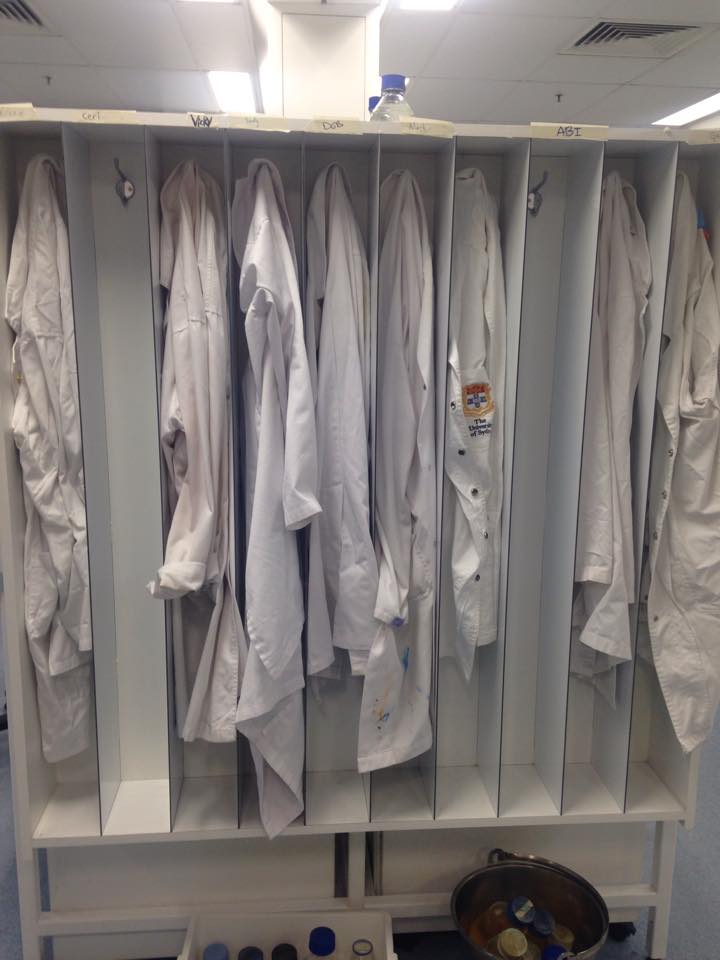Team:Sydney Australia/Safety
General laboratory safety
In order for our group to be allowed to work in the laboratory, we had to go through extensive safety training both online and practical. This was undertaken to minimise accidents to ourselves, others, and the environment.
The training covered the following:
- Personal protective equipment -
- Lab coats, long hair tied back, enclosed shoes, and washing hands with disinfectant when leaving the laboratory. Gloves and safety googles were required when working with corrosives, acids, bases, and alcohols.
- Laboratory safety equipment
- Locations and operation of emergency showers, emergency eyewash, fire extinguisher, fire blanket and the panic button.
- Building safety
- The location of the fire escapes, and evacuation area, along with the details of the First Aid Officers.
Project specific laboratory safety
As we were working in a Physical Containment Level 2 Laboratory (PC-2), additional training was required specific to our project. This included:
- Chemical safety
- Extensive knowledge of the chemicals used, safety equipment required in their use (such as the Fumehood) and, correct methods of disposal, along with the online and physical location of MSDS sheets.
- GMO safety
- All biological material was autoclaved before disposal, to prevent release of these recombinant organisms into the environment. Furthermore, we ensured none of the genes (both whole and fragmentary) would act as virulence factors, and that no known pathogens would be involved in our research.
- BioBrick safety
- None of the parts we created encode virulence factors or toxins known to be a threat to human or animal health, which was confirmed by BLAST searches of each of the sequences. No parts had sequences sourced from known human or animal pathogens.
Would any of your project ideas raise safety issues in terms of researcher safety, public safety, or environmental safety?
Despite exclusively using non-pathogenic laboratory strains of bacteria, our team endeavoured to further reduce the risk of handling the recombinant microorganisms that we made. This was done by conducting our research in a physical containment 2 (PC-2, equivalent to BSL-2) lab, where all biological material was autoclaved before disposal, to prevent release of these recombinant organisms into the environment. Correct PPE, including gloves and lab coats, were worn at all times, and additional PPE, such as safety glasses, was worn when there was a chemical or particulate hazard. Hand washing was conducted when entering or leaving the lab, and aseptic techniques were adhered to when working with microorganisms.
Additionally, we ensured that none of the genes or parts that we were assembling would act as virulence factors, and that no known pathogens would be involved in our research, with our research plan cleared with the University of Sydney Biosafety Committee. Our team exclusively used non-pathogenic laboratory strains of Escherichia coli and Pseudomonas Putids for all parts of our project. Although antibiotic resistance genes were used as selectable markers in many of our constructs, it is unlikely that these genes would allow for pathogenicity in the lab strains of E. coli and P. putids that were used.
Do any of the new BioBrick parts (or devices) that you made this year raise safety issues?
None of the parts we created encode virulence factors or toxins known to be a threat to human or animal health, which was confirmed by BLAST searches of each of the sequences. No parts had sequences sourced from known human or animal pathogens.
Is there a local biosafety group, committee, or review board at your institution?
An Institutional Biosafety Committee (IBC) operates at the University of Sydney. All projects involving genetically modified organisms (GMO) must be reported to and approved by the committee. The regulations are derived from the Australian Gene Technology Act 2001. Our project has been approved and complies with the IBC’s biosafety policies and regulations. The School of Molecular Bioscience also has a set of well-documented standard operating procedures.
All training and work was undertaken in accordance with the Australian Standard For Safety in Laboratories - Microbiology (AS/NZS 2243.3:2010), for GMO specific regulations we followed the Guidelines established by the Australian Gene Technology Act (2000), and the Sydney University Institutional Biosafety Committee (IBC). Our project was covered by previous applications to the IBC and work was undertaken in accordance with the School of Molecular Bioscience standard operating procedures.
In our project we worked with non-pathogenic laboratory strains of Escherichia Coli, Mycobacterium Smegmatis and Pseudomonas Putida . Although antibiotic resistance genes were used as selectable markers in many of our constructs, it is unlikely that these genes would allow for pathogenicity in the bacterial lab strains that were used.

